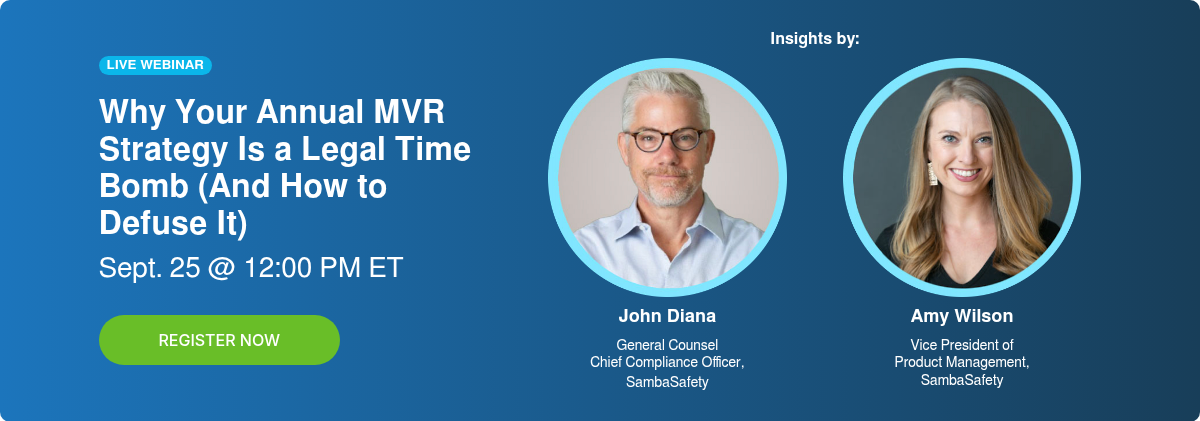
Nuclear verdicts in commercial vehicle accident litigation have become a fleet manager's worst nightmare, with average jury awards skyrocketing to staggering levels.
Understanding nuclear verdicts and their devastating impact is just the first step; the real question is how to prevent nuclear verdicts in commercial vehicle litigation before they destroy your business. This blog reveals nuclear verdicts trends that every fleet operator must understand, along with four strategies that leading organizations use to transform potential legal liabilities into strategic advantages. From continuous driver monitoring to building bulletproof safety cultures, these actionable insights will help you stay ahead of aggressive litigation tactics and better protect both your drivers and your bottom line.
Key Takeaways
- Why nuclear verdicts are skyrocketing and how evolving jury expectations are reshaping the legal landscape for fleet operators.
- How modern legal strategies like Reptile Theory weaponize safety gaps and inconsistent policies to drive massive payouts.
- Four actionable defense strategies that can help protect your fleet from catastrophic litigation.
The $214 Million Wake-Up Call
What Are Nuclear Verdicts?
Nuclear verdicts, or jury awards over $10 million in personal injury cases, have become a growing threat in commercial vehicle litigation. As John Diana, General Counsel and Chief Compliance Officer at SambaSafety, recalls: “I once heard a litigator say it’s when you lose your breath while listening in court as a defense attorney.” That moment of disbelief reflects the scale of these staggering verdicts and the immense pressure they place on companies caught off guard.
These verdicts reveal more than just the facts of a single crash. Juries are increasingly focused on the broader picture: how companies manage safety, train drivers and handle risk. When they see patterns of negligence or weak safety cultures, the financial consequences can be crippling.
Between 2015 and 2019, the average top verdict in commercial vehicle cases soared from $64 million to $214 million. That kind of increase is a clear signal that juries are holding companies to a higher standard. For fleet operators, this shift is a serious wake-up call.
These outcomes may be severe, but they aren’t inevitable. Preventing nuclear verdicts starts with the decisions your organization makes every day—how you prioritize safety, document compliance and build trust through accountability. The courtroom may be where the verdict is delivered, but the groundwork is laid long before that.
Why Nuclear Verdicts Are Targeting Your Fleet
Nuclear Verdicts Trends Reshaping Commercial Litigation
The statistics surrounding commercial vehicle risk paint a clear picture of why these cases have become litigation gold mines. Auto crashes remain the leading cause of workplace fatalities, accounting for 22% of all workplace deaths. More alarmingly, 52% of all personal injury lawsuits stem from auto crashes—and most of these are won by plaintiffs.
This surge in nuclear verdicts has created a ripple effect throughout the insurance industry. The traditional strategy of simply raising rates to cover increased risk has reached a breaking point, forcing both insurers and fleet operators to focus more on prevention rather than coverage.
The Reptile Theory Threat
Modern litigation has evolved far beyond establishing fault in individual crash events. Plaintiff attorneys now employ sophisticated strategies like "Reptile Theory"—a psychological approach that frames companies as dangerous threats to public safety. Rather than focusing on the specific crash, attorneys paint a narrative where your company's safety practices (or lack thereof) represent a clear and present danger to the community.
This strategy is highly effective because it bypasses rational analysis and activates jurors' survival instincts. The message becomes clear: this company must be punished to protect society from future harm.
Advancements in technology have also given companies unprecedented visibility into driver behavior and risk, shifting the standard of care. Annual MVR reviews alone are no longer enough.
The Legal Reality
The shift in nuclear verdicts in commercial vehicle accident litigation reflects a critical evolution in how courts view corporate responsibility. Modern litigation operates on two distinct standards of negligence:
Driver-level negligence focuses on the hundreds of judgment calls made during a single trip—speed, lane changes, cell phone use and weather decisions. This is the traditional realm of traffic incident litigation.
Company-level negligence casts a much wider net, examining your entire approach to risk management. Did you know or should you have known this driver was dangerous? What systems did you have in place to monitor risk? How did you intervene when warning signs appeared?
The old defense of "I didn't know" no longer holds water in court. Companies are now expected to maintain continuous awareness of driver risk, and failing to act on easily knowable information can open the door to massive negligence claims.
4 Strategies for Responding to Nuclear Verdict Trends
Strategy 1: Build Continuous Risk Visibility
Most fleet operators still rely on annual MVR checks, creating what experts call "the visibility gap." This approach leaves your organization blind to critical risk changes for up to 364 days. Research shows that 3 to 5% of drivers operate with suspended licenses at any given time, meaning traditional annual checks virtually guarantee you have disqualified drivers on the road.
The legal implications are severe. A driver could receive a DUI, lose their license or accumulate serious violations the day after your annual check, and you might not discover this until the following year—potentially after a serious incident.
Leading organizations have moved beyond annual snapshots to implement continuous driver monitoring systems that provide ongoing alerts about license status changes, new violations, CSA events and dangerous driving behaviors. Some systems can even integrate these driver insights with other data sources to create a comprehensive risk profile for each driver.
This approach quantifies risk through intelligent scoring systems that help prioritize interventions. When you can identify your highest-risk drivers and address issues immediately, you transform reactive, risky compliance into proactive risk management.
Strategy 2: Create Your Intervention Playbook
Inconsistent safety practices are one of the quickest ways to lose a nuclear verdict case. Plaintiff attorneys look for gaps: policies that aren’t followed, standards applied unevenly or decisions made without clear guidelines. Every inconsistency becomes a potential piece of evidence pointing to negligence.
To protect your fleet, you need a clear, documented intervention playbook that removes guesswork from safety decisions. When a driver receives a speeding violation, what happens next? If telematics data flags harsh braking or aggressive cornering, who is alerted and how quickly? Safety interventions are most effective when they happen immediately after a risk event. These responses must be standardized and repeatable, not left to individual discretion.
That’s where targeted driver training comes in. Modern intervention strategies use data analytics to match specific risk behaviors with relevant, bite-sized training modules. If a driver is flagged for harsh cornering, they can receive a short, engaging lesson on safe turning techniques. If an MVR shows a speeding violation, the training focuses on speed control—not general safety reminders.
The results are significant: according to SambaSafety insights, fleets using continuous monitoring and targeted interventions can reduce violations by up to 77% in a year—leading to fewer crashes, lower litigation risk and more stable insurance costs.
This targeted approach improves retention, changes behavior more effectively and builds a documented record of proactive safety management. That record serves as a powerful defense.
Strategy 3: Address the Non-Owned Vehicle Gap
A growing blind spot in fleet risk management involves employees who drive personal vehicles for work—what the industry calls "non-owned auto exposure." As companies reduce owned fleets and shift to vehicle allowance programs, they often apply different safety standards to these drivers, creating what plaintiff attorneys see as a "safety double standard."
As Greg Stefan, Senior Vice President of Risk Control at Arch Insurance Group, warns: “If an employer understands the risk associated with company-owned vehicles and takes appropriate actions but chooses not to take appropriate actions with the non-owned drivers… a plaintiff’s attorney will have significant reasons for proving employer negligence.”
Recognizing risk in one driver group while ignoring it in another can open the door to detrimental legal repercussions.
Effective risk management programs apply consistent safety policies across all driver types, regardless of vehicle ownership. This means continuous driver monitoring, regular training and clear intervention protocols for allowance program participants just as rigorously as company vehicle drivers.
The goal is eliminating any narrative that suggests your organization recognized risks with one driver population while ignoring similar risks with another. In nuclear verdict litigation, this kind of selective oversight becomes powerful evidence of corporate negligence.
Strategy 4: Document Your Driver Safety Efforts
The strongest defense against nuclear verdicts starts well before an incident—with consistent documentation of safety efforts. Every training session, coaching interaction and policy update helps build a clear narrative of proactive risk management. Courts value genuine, ongoing safety practices over reactive policies.
Technology enhances this story. Platforms that integrate MVRs, telematics, CSA events and other critical driving data give real-time insight into risk. Predictive analytics enable targeted, behavior-based training, supported by a documented trail of consistent action.
Don’t Wait for a Verdict to Change Your Strategy
The strongest legal defense against nuclear verdicts begins long before an incident occurs. Inconsistent safety practices and delayed action leave organizations exposed to catastrophic litigation. Avoiding these outcomes requires more than surface-level fixes: it demands a smarter, more connected approach to risk management that spans every aspect of driver safety.
Watch our free webinar: Why Your Annual MVR Strategy Is a Legal Time Bomb (And How to Defuse It) to explore expert-driven strategies that replace outdated safety practices, reduce legal risk, meet evolving standards and position safety tech as a tool for employee growth and proactive risk management.




